-
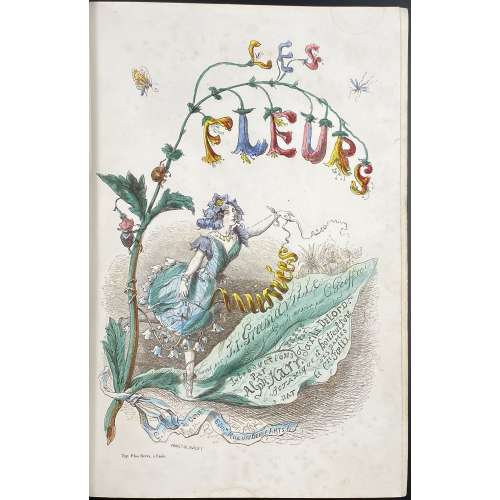 Description: Two parts in one volume, collated 4to, 26.3 x 18 cm, bound in quarter green pebbled morocco over green percaline panelled boards, spine with raised bands, gilt in compartments, lettered in gilt, signed in the bottom “L. Curmer”; marbled endpapers, all edges gilt. Part 1 is illustrated with a hand-coloured wood-engraved title-page by Porret and Blanadet and 28 hand-coloured steel engravings by Charles Geoffroy after J.-J. Grandville; part 2 is illustrated with a hand-coloured wood-engraved title-page by Quichon and 22 steel engravings by Charles Geoffroy after J.-J. Grandville, and two uncoloured botanical plates, unsigned. Title-page: LES | FLEURS ANIMÉES | PAR | J.-J. GRANDVILLE | INTRODUCTIONS | Par ALPH. KARR | TEXTE | Par TAXILE DELORD | — | PREMIÈRE (DEUXIÈME) PARTIE | — | PARIS | GABRIEL DE GONET, ÉDITEUR | 6, RUE DES BEAUX-ARTS, 6 || Collation: part 1: blank, [1] h.t./imprint (PARIS WALDER), hand-coloured engraved t.p., [1] t.p./blank, 1-324, [1] contents/blank, 28 hand-coloured plates; part 2: [1] h.t./imprint (PARIS WALDER), hand-coloured engraved t.p., [1] t.p./blank, [2] intro., [1]-294, 302, blank, 22 hand-coloured plates and 2 uncoloured plates. Pagination: part 1: [1-5] 6-260 [2] (total 262 pages), ils; part 2: [4] [i] ii-iv [1] 2-102, [2] [i] ii-iv, [105] 106-234 [2] (total 248 pages), ils. Coloured steel-engraved plates: Part 1: Bleuet et Coquelicot. Lis. Pensée. Tabac. Tulipe. Rose. Narcisse. Violette. Nenuphar. Laurier. Myrte. Marguerite. Camelia. Immortelle. Chèvre-feuille. Belle-de-nuit. Oeillet. Ciguë. Soleil. Fleur de grenadier. Lin. Eglantine. Pavot. Chardon. Fleur d'oranger. Capucine. Guimauve. Primevère – Perce-neige. Part 2: Pois de senteur. Cactus. Dahlia. Sensitive. Fleur de pêcher. Aubépine. Vigne. Myosotis. Jasmin. Scabieuse & Souci. Traite des fleurs. Flèche-d'eau. Hortensia, couronne impériale. Verveine. Giroflée. Thé et Café. Lilas. Tubéreuse Jonquille. Bal. Retour des fleurs. Erratum. Pervenche desséchée. Plates signed "Grandville del. – Ch. Geoffroy sc. – G. de Gonet, editeur" but some signed "Imp. Delamain et Sarazin rue Git le Cœur 8 Paris." Plates accompanied by tissue guards. Gordon N. Ray: "Most of the plates show an elegant lady in a garden, her dress covered with an extraordinary pattern of flowers. She is sometimes accompanied by respectful creatures, animals and insects, even fish and reptiles". Edition: 2nd edition of 1847, each part has separate pagination; imprint: "Paris. — Typographie Walder, rue Bonaparte, 44". Second "tirage", the volumes being paged separately; the first "tirage", issued also in 1847, is paged continuously. Point of issue: Table des Matières has "Imprimerte Walder." Originally appeared in 83 separate parts in pictorial yellow wrappers. Contributors: J.-J. Grandville [Gèrard, Isidore-Adolphe] (French, 1803 – 1847) – artist. Taxile Delord (French, 1815 – 1877) – author. Comte Foelix [Louis-François Raban] (French, 1795 – 1870) – author. Jean-Baptiste Alphonse Karr (French, 1808 – 1890) – author. Charles Michel Geoffroy (French, 1819 – 1882) – engraver (on steel). Gabriel de Gonet (French, fl. 1847 – 1862) – publisher. Typographie Walder (Paris) – printer. Plon Freres (Paris) – printer. Delamain et Sarrazin (Paris) – printer. Henri Désiré Porret (French, 1800 – 1867) – engraver (on wood). Jules Blanadet (French, 1824 – ?) – engraver (on wood). Quichon (French, fl. c. 1850s) – engraver (on wood). Catalogue raisonné: L. Carteret (Le trésor): p. 286; Ray (French): 198, pp. 278-9; Vicaire (Manuel): D III, p. 133-4; Brivois (Guide): pp. 147-150. In collections: MET 1970.565.423.1–.2; Vanderbilt University; V&A L.755-1943. Provenance: Léon Curmer (French, ).
Description: Two parts in one volume, collated 4to, 26.3 x 18 cm, bound in quarter green pebbled morocco over green percaline panelled boards, spine with raised bands, gilt in compartments, lettered in gilt, signed in the bottom “L. Curmer”; marbled endpapers, all edges gilt. Part 1 is illustrated with a hand-coloured wood-engraved title-page by Porret and Blanadet and 28 hand-coloured steel engravings by Charles Geoffroy after J.-J. Grandville; part 2 is illustrated with a hand-coloured wood-engraved title-page by Quichon and 22 steel engravings by Charles Geoffroy after J.-J. Grandville, and two uncoloured botanical plates, unsigned. Title-page: LES | FLEURS ANIMÉES | PAR | J.-J. GRANDVILLE | INTRODUCTIONS | Par ALPH. KARR | TEXTE | Par TAXILE DELORD | — | PREMIÈRE (DEUXIÈME) PARTIE | — | PARIS | GABRIEL DE GONET, ÉDITEUR | 6, RUE DES BEAUX-ARTS, 6 || Collation: part 1: blank, [1] h.t./imprint (PARIS WALDER), hand-coloured engraved t.p., [1] t.p./blank, 1-324, [1] contents/blank, 28 hand-coloured plates; part 2: [1] h.t./imprint (PARIS WALDER), hand-coloured engraved t.p., [1] t.p./blank, [2] intro., [1]-294, 302, blank, 22 hand-coloured plates and 2 uncoloured plates. Pagination: part 1: [1-5] 6-260 [2] (total 262 pages), ils; part 2: [4] [i] ii-iv [1] 2-102, [2] [i] ii-iv, [105] 106-234 [2] (total 248 pages), ils. Coloured steel-engraved plates: Part 1: Bleuet et Coquelicot. Lis. Pensée. Tabac. Tulipe. Rose. Narcisse. Violette. Nenuphar. Laurier. Myrte. Marguerite. Camelia. Immortelle. Chèvre-feuille. Belle-de-nuit. Oeillet. Ciguë. Soleil. Fleur de grenadier. Lin. Eglantine. Pavot. Chardon. Fleur d'oranger. Capucine. Guimauve. Primevère – Perce-neige. Part 2: Pois de senteur. Cactus. Dahlia. Sensitive. Fleur de pêcher. Aubépine. Vigne. Myosotis. Jasmin. Scabieuse & Souci. Traite des fleurs. Flèche-d'eau. Hortensia, couronne impériale. Verveine. Giroflée. Thé et Café. Lilas. Tubéreuse Jonquille. Bal. Retour des fleurs. Erratum. Pervenche desséchée. Plates signed "Grandville del. – Ch. Geoffroy sc. – G. de Gonet, editeur" but some signed "Imp. Delamain et Sarazin rue Git le Cœur 8 Paris." Plates accompanied by tissue guards. Gordon N. Ray: "Most of the plates show an elegant lady in a garden, her dress covered with an extraordinary pattern of flowers. She is sometimes accompanied by respectful creatures, animals and insects, even fish and reptiles". Edition: 2nd edition of 1847, each part has separate pagination; imprint: "Paris. — Typographie Walder, rue Bonaparte, 44". Second "tirage", the volumes being paged separately; the first "tirage", issued also in 1847, is paged continuously. Point of issue: Table des Matières has "Imprimerte Walder." Originally appeared in 83 separate parts in pictorial yellow wrappers. Contributors: J.-J. Grandville [Gèrard, Isidore-Adolphe] (French, 1803 – 1847) – artist. Taxile Delord (French, 1815 – 1877) – author. Comte Foelix [Louis-François Raban] (French, 1795 – 1870) – author. Jean-Baptiste Alphonse Karr (French, 1808 – 1890) – author. Charles Michel Geoffroy (French, 1819 – 1882) – engraver (on steel). Gabriel de Gonet (French, fl. 1847 – 1862) – publisher. Typographie Walder (Paris) – printer. Plon Freres (Paris) – printer. Delamain et Sarrazin (Paris) – printer. Henri Désiré Porret (French, 1800 – 1867) – engraver (on wood). Jules Blanadet (French, 1824 – ?) – engraver (on wood). Quichon (French, fl. c. 1850s) – engraver (on wood). Catalogue raisonné: L. Carteret (Le trésor): p. 286; Ray (French): 198, pp. 278-9; Vicaire (Manuel): D III, p. 133-4; Brivois (Guide): pp. 147-150. In collections: MET 1970.565.423.1–.2; Vanderbilt University; V&A L.755-1943. Provenance: Léon Curmer (French, ). -
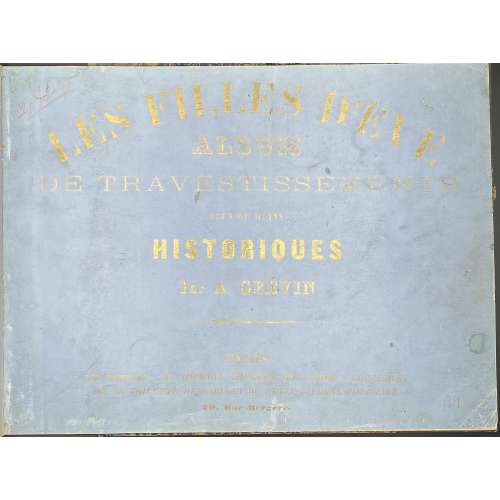 Pictorial album of 20 hand-coloured wood engravings by Firmin Gillot after Alfred Grévin; numbered 1 to 20, bound with tissue guards in half-brown cloth over marbled boards, publisher's gilt-lettered blue wrappers preserved, purple-blueish endpapers. Front wrapper (gilt on blue): LES FILLES D'EVE | ALBUM | DE TRAVESTISSEMENTS | PLUS OU MOINS | HISTORIQUES | Par A. GRÉVIN | — | PARIS | AUX BUREAUX : DU JOURNAL AMUSANT, DES MODES PARISIENNES | DE LA TOILETTE DE PARIS ET DU PETIT JOURNAL POUR RIRE | 20. Rue Bergère. || ; Henri Plon's imprint to back wrapper. Contributors: Grevin, Alfred (French, 1827 – 1892) Gillot, Firmin (French, 1820 – 1872) Plon, Henri (French, 1806 – 1872) Ref.: Metropoliten Museum.
Pictorial album of 20 hand-coloured wood engravings by Firmin Gillot after Alfred Grévin; numbered 1 to 20, bound with tissue guards in half-brown cloth over marbled boards, publisher's gilt-lettered blue wrappers preserved, purple-blueish endpapers. Front wrapper (gilt on blue): LES FILLES D'EVE | ALBUM | DE TRAVESTISSEMENTS | PLUS OU MOINS | HISTORIQUES | Par A. GRÉVIN | — | PARIS | AUX BUREAUX : DU JOURNAL AMUSANT, DES MODES PARISIENNES | DE LA TOILETTE DE PARIS ET DU PETIT JOURNAL POUR RIRE | 20. Rue Bergère. || ; Henri Plon's imprint to back wrapper. Contributors: Grevin, Alfred (French, 1827 – 1892) Gillot, Firmin (French, 1820 – 1872) Plon, Henri (French, 1806 – 1872) Ref.: Metropoliten Museum. -
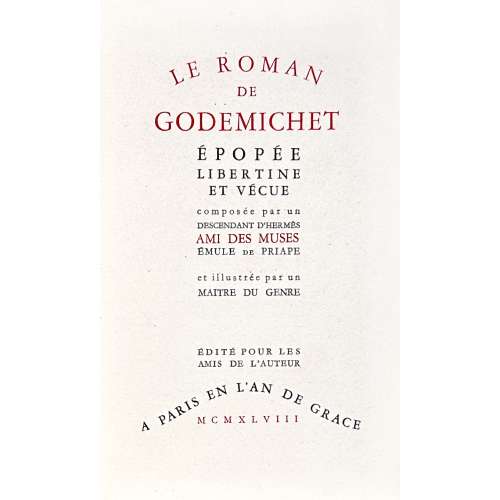 Softcover volume, 23.5 x 15 cm, in tan French flapped wrappers with red lettering to front, collated in-4to, in a tan double slipcase 24 x 15 cm with red lettered label to spine, pp.: [1-12] 13-112 [8], total 120 pages, incl. those within wrappers; printed on thick wove paper watermarked “Lafuma Frères”, 5 full-page and 6 half-page illustrations within collation, incl. frontispiece, guard tissue laid in. Title-page (red and black): LE ROMAN | DE | GODEMICHET | ÉPOPÉE | LIBERTINE | ET VÉCUE | composée par un | DESCENDANT D’HERMES | AMI DES MUSES | ÉMULE DE PRIAPE | et illustrée par un | MAITRE DU GENRE | ÉDITÉ POUR LES | AMIS DE L’AUTEUR | A PARIS EN L’AN DE GRACE | MCMXLVIII || Limited edition 200 + XX, this is copy № 175. Catalogue raisonné: Dutel III № 2336. Jean Reschofsky (French, 1905 – 1998) – artist.
Softcover volume, 23.5 x 15 cm, in tan French flapped wrappers with red lettering to front, collated in-4to, in a tan double slipcase 24 x 15 cm with red lettered label to spine, pp.: [1-12] 13-112 [8], total 120 pages, incl. those within wrappers; printed on thick wove paper watermarked “Lafuma Frères”, 5 full-page and 6 half-page illustrations within collation, incl. frontispiece, guard tissue laid in. Title-page (red and black): LE ROMAN | DE | GODEMICHET | ÉPOPÉE | LIBERTINE | ET VÉCUE | composée par un | DESCENDANT D’HERMES | AMI DES MUSES | ÉMULE DE PRIAPE | et illustrée par un | MAITRE DU GENRE | ÉDITÉ POUR LES | AMIS DE L’AUTEUR | A PARIS EN L’AN DE GRACE | MCMXLVIII || Limited edition 200 + XX, this is copy № 175. Catalogue raisonné: Dutel III № 2336. Jean Reschofsky (French, 1905 – 1998) – artist. -
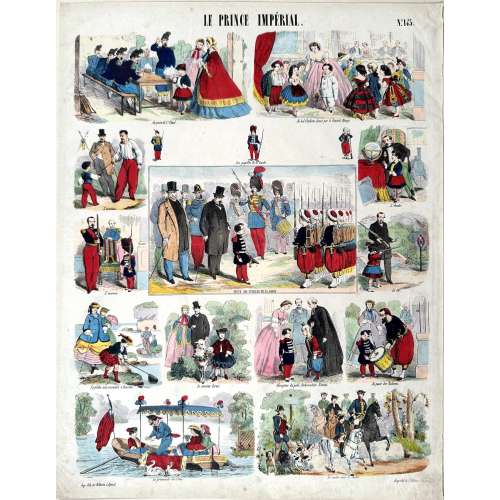 Hand-coloured woodcut on wove paper, 472 x 365 mm; black ink stamp “5275” to reverse. Top centre: "LE PRINCE IMPÉRIAL"; right: "№143." Image in the middle: Prince Impérial, with his father, conducts a review of the children's army "REVUE DES PUPILLES DE LA GARDE". Besides – five tiers of captioned cartoons. Bottom left: "Imp. lith. de Pellerin à Épinal"; right: Propriété de l’Éditeur. Déposé." Jean Charles Pellerin (French, 1756 – 1836) – printer/publisher.
Hand-coloured woodcut on wove paper, 472 x 365 mm; black ink stamp “5275” to reverse. Top centre: "LE PRINCE IMPÉRIAL"; right: "№143." Image in the middle: Prince Impérial, with his father, conducts a review of the children's army "REVUE DES PUPILLES DE LA GARDE". Besides – five tiers of captioned cartoons. Bottom left: "Imp. lith. de Pellerin à Épinal"; right: Propriété de l’Éditeur. Déposé." Jean Charles Pellerin (French, 1756 – 1836) – printer/publisher. -
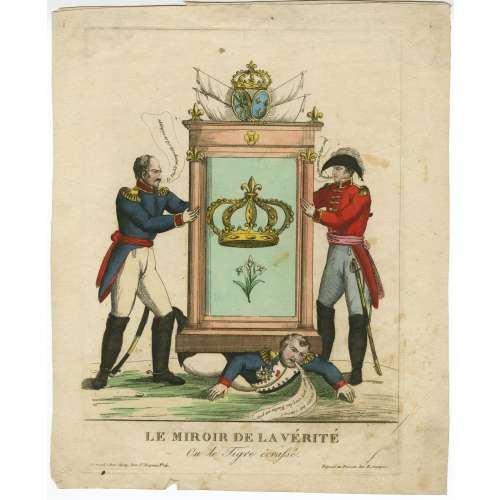 Hand-coloured etching by an anonymous artist, printed in July 1815. Description by British Museum (1866,0407.935): "Blücher (left) and Napoleon (right) support a heavy pier-glass in an upright position. Its solid base rests on the back of the prostrate Napoleon, from whose mouth issues a label: 'Si je pouvais encore me sauver! . . . mais non c'est fini Nicolas est pris.' The mirror, which towers above the head of its supporters, is framed by pillars, each surmounted by a fleur-de-lis. These also decorate the heavy superstructure which supports a trophy of two oval shields with the arms of Bourbon and Navarre, surmounted by a crown..., and four white flags. On the face of the mirror is a large Bourbon crown, and a lily plant. Blücher says: "Le Diable m'emporte s'il en réchappe." Wellington responds: "Pour cette fois nous en répondons." Inscription under the plate: 'Se vend chez Genty, rue St Jacques no.14' and 'Déposé au Bureau des Estampes'. Size: 33.2 x 25.7 cm
Hand-coloured etching by an anonymous artist, printed in July 1815. Description by British Museum (1866,0407.935): "Blücher (left) and Napoleon (right) support a heavy pier-glass in an upright position. Its solid base rests on the back of the prostrate Napoleon, from whose mouth issues a label: 'Si je pouvais encore me sauver! . . . mais non c'est fini Nicolas est pris.' The mirror, which towers above the head of its supporters, is framed by pillars, each surmounted by a fleur-de-lis. These also decorate the heavy superstructure which supports a trophy of two oval shields with the arms of Bourbon and Navarre, surmounted by a crown..., and four white flags. On the face of the mirror is a large Bourbon crown, and a lily plant. Blücher says: "Le Diable m'emporte s'il en réchappe." Wellington responds: "Pour cette fois nous en répondons." Inscription under the plate: 'Se vend chez Genty, rue St Jacques no.14' and 'Déposé au Bureau des Estampes'. Size: 33.2 x 25.7 cm -
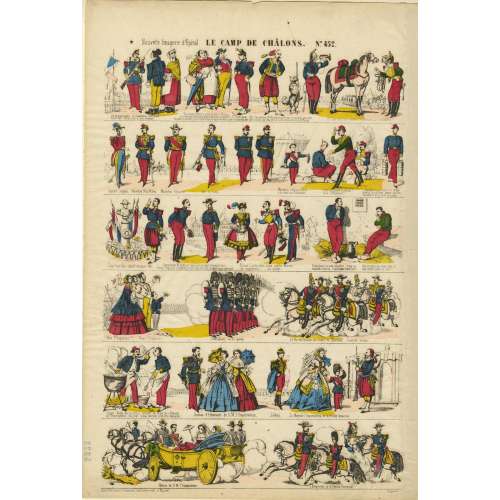 Hand-coloured woodcut on wove paper, 409 x 280 mm; black ink stamp “5323” to reverse; attached to the sheet 487 x 320 mm. Top centre: "LE CAMP DE CHALONS."; left: "Nouvelle Imagerre d'Epinal"; right: № 452. Bottom left: "Imp lith. Pinot & Sagaire, libraires edit. à Épinal"; right: "Déposé". Image: 6-tier cartoon with captions about Napoleon III and his son Prince Imperial (Napoléon Eugène Louis Jean Joseph Bonaparte; 16 March 1856 – 1 June 1879). Le camp de Chalons Pinot & Sagaire (Épinal, 1861 – 1888) – enterprise, publisher/printer. Charles-François Pinot (French, 1817 – 1879) – publisher/printer.
Hand-coloured woodcut on wove paper, 409 x 280 mm; black ink stamp “5323” to reverse; attached to the sheet 487 x 320 mm. Top centre: "LE CAMP DE CHALONS."; left: "Nouvelle Imagerre d'Epinal"; right: № 452. Bottom left: "Imp lith. Pinot & Sagaire, libraires edit. à Épinal"; right: "Déposé". Image: 6-tier cartoon with captions about Napoleon III and his son Prince Imperial (Napoléon Eugène Louis Jean Joseph Bonaparte; 16 March 1856 – 1 June 1879). Le camp de Chalons Pinot & Sagaire (Épinal, 1861 – 1888) – enterprise, publisher/printer. Charles-François Pinot (French, 1817 – 1879) – publisher/printer. -
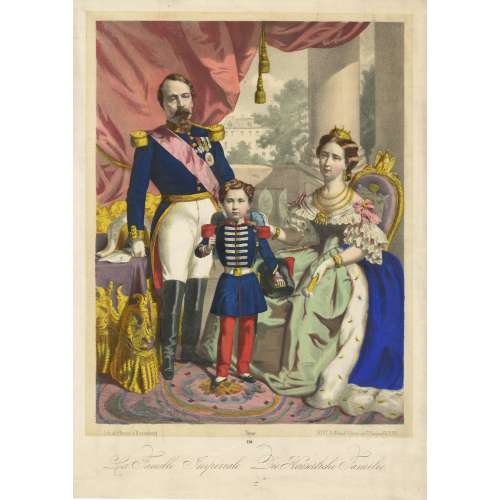 Hand-coloured lithography on wove paper, 395 x 280 mm; black ink stamp “5309” to reverse. On image: artist's initials "L. H."; on stone: "Lith. de Fr. Wentzel a Wissembourg. — Déposé — DÉPÔT, Fr. Wentzel Editeur rue St. Jacques 65, PARIS"; below centre: "239"; bottom : La famille Impériale. Die Kaizerliche Familie. Napoleon III [Charles-Louis Napoléon Bonaparte] (French, 1808 – 1873) Eugénie de Montijo [L'impératrice Eugénie] (Spanish-French, 1826 – 1920) Napoléon, Prince Imperial (Napoléon Eugène Louis Jean Joseph Bonaparte] (French, 1856 – 1879) Jean Frédéric Wentzel (French, 1807 – 1869) – publisher/printer.
Hand-coloured lithography on wove paper, 395 x 280 mm; black ink stamp “5309” to reverse. On image: artist's initials "L. H."; on stone: "Lith. de Fr. Wentzel a Wissembourg. — Déposé — DÉPÔT, Fr. Wentzel Editeur rue St. Jacques 65, PARIS"; below centre: "239"; bottom : La famille Impériale. Die Kaizerliche Familie. Napoleon III [Charles-Louis Napoléon Bonaparte] (French, 1808 – 1873) Eugénie de Montijo [L'impératrice Eugénie] (Spanish-French, 1826 – 1920) Napoléon, Prince Imperial (Napoléon Eugène Louis Jean Joseph Bonaparte] (French, 1856 – 1879) Jean Frédéric Wentzel (French, 1807 – 1869) – publisher/printer. -
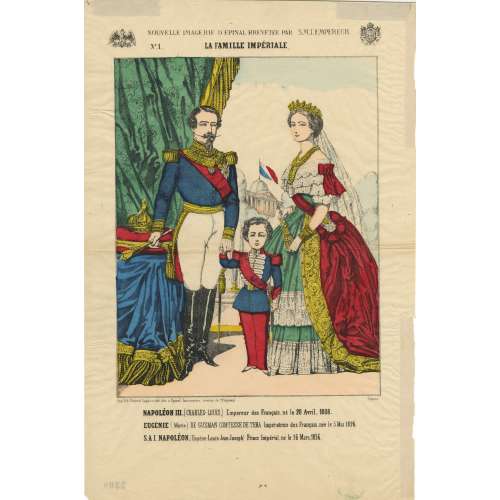 Hand-coloured woodcut on wove paper, 390 x 260 mm; black ink stamp “5308” to reverse; horizontal centerfold. Centre top: "NOUVELLE IMAGERIE D'ÉPINAL BREVETÉE PAR S.M.L’EMPEREUR" with imperial eagle and coat of arms at right and left. Below: "№ 1." — "LA FAMILLE IMPÉRIALE"; image in frame; under the image, left: "Imp lith. Pinot & Sagaire, édit. libr. à Épinal, fournisseurs brevetés de l’Empereur"; right: "Déposé". Bottom: "NAPOLÉON I. (CHARLES-LOUIS,) Empereur des Français, né le 20 Avril, 1808. | EUGÉNIE ( Marie) DE GUSMAN COMTESSE DE TEBA Impératrice des Français, née le 5 Mai 1826. | S.A I. NAPOLÉON. (Eugène-Louis-Jean-Joseph) Prince Impérial, ne le 16 Mars. 1856." Napoleon III [Charles-Louis Napoléon Bonaparte] (French, 1808 – 1873) Eugénie de Montijo [L'impératrice Eugénie] (Spanish-French, 1826 – 1920) Napoléon, Prince Imperial (Napoléon Eugène Louis Jean Joseph Bonaparte] (French, 1856 – 1879) Pinot & Sagaire (Épinal, 1861 – 1888) – enterprise, publisher/printer. Charles-François Pinot (French, 1817 – 1879) – publisher/printer.
Hand-coloured woodcut on wove paper, 390 x 260 mm; black ink stamp “5308” to reverse; horizontal centerfold. Centre top: "NOUVELLE IMAGERIE D'ÉPINAL BREVETÉE PAR S.M.L’EMPEREUR" with imperial eagle and coat of arms at right and left. Below: "№ 1." — "LA FAMILLE IMPÉRIALE"; image in frame; under the image, left: "Imp lith. Pinot & Sagaire, édit. libr. à Épinal, fournisseurs brevetés de l’Empereur"; right: "Déposé". Bottom: "NAPOLÉON I. (CHARLES-LOUIS,) Empereur des Français, né le 20 Avril, 1808. | EUGÉNIE ( Marie) DE GUSMAN COMTESSE DE TEBA Impératrice des Français, née le 5 Mai 1826. | S.A I. NAPOLÉON. (Eugène-Louis-Jean-Joseph) Prince Impérial, ne le 16 Mars. 1856." Napoleon III [Charles-Louis Napoléon Bonaparte] (French, 1808 – 1873) Eugénie de Montijo [L'impératrice Eugénie] (Spanish-French, 1826 – 1920) Napoléon, Prince Imperial (Napoléon Eugène Louis Jean Joseph Bonaparte] (French, 1856 – 1879) Pinot & Sagaire (Épinal, 1861 – 1888) – enterprise, publisher/printer. Charles-François Pinot (French, 1817 – 1879) – publisher/printer. -
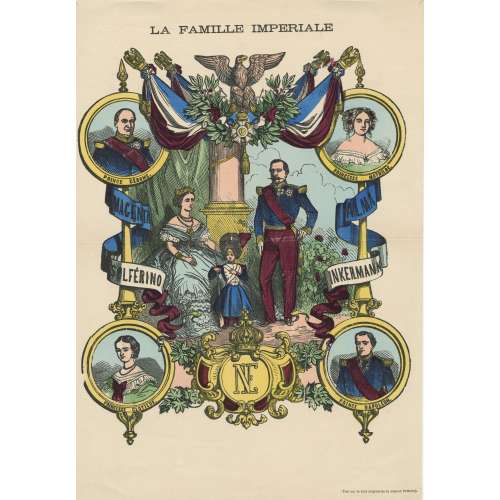 Hand-coloured woodcut on laid paper, 422 x 294 mm; black ink stamp “5307” to reverse, centrefold. Top center: "LA FAMILLE IMPERIALE"; Bottom right: "(Tire sur le bois original de maison Pellerin)". Image: Napoléon III, Empress Eugenie, and Prince Imperial Louis-Napoléon as a child surrounded with four lettered medallions: “PRINCE GÉROME”, “PRINCESSE MATHILDE”, “PRINCESSE CLOTILDE”, and “PRINCE NAPOLÉON”; ribbons lettered: “MAGENTA”, SOLFERINO”, “ALMA”, and “INKERMANN” around heraldic spears; coat of arms with imperial monogram between Princesse Clotilde and Prince Napoléon. Publisher/printer: Jean Charles Pellerin (French, 1756 – 1836). Battle of Magenta : 4 June 1859, against the Austrians. Battle of Solferino : 24 June 1859, against the Austrians. Battle of the Alma : 20 September 1854 (Crimean War) Battle of Inkerman : 5 November 1854 (Crimean War) Characters: Napoleon III [Charles-Louis Napoléon Bonaparte] (French, 1808 – 1873) Eugénie de Montijo [L'impératrice Eugénie] (Spanish-French, 1826 – 1920) Napoléon, Prince Imperial (Napoléon Eugène Louis Jean Joseph Bonaparte] (French, 1856 – 1879) Napoléon-Jérôme Bonaparte [Prince Jérôme] (French, 1822 – 1891) Mathilde Bonaparte [Princess Mathilde] (French, 1820 – 1904) Marie-Clotilde de Savoie [Princesse Clotilde] (French, 1843 – 1911)
Hand-coloured woodcut on laid paper, 422 x 294 mm; black ink stamp “5307” to reverse, centrefold. Top center: "LA FAMILLE IMPERIALE"; Bottom right: "(Tire sur le bois original de maison Pellerin)". Image: Napoléon III, Empress Eugenie, and Prince Imperial Louis-Napoléon as a child surrounded with four lettered medallions: “PRINCE GÉROME”, “PRINCESSE MATHILDE”, “PRINCESSE CLOTILDE”, and “PRINCE NAPOLÉON”; ribbons lettered: “MAGENTA”, SOLFERINO”, “ALMA”, and “INKERMANN” around heraldic spears; coat of arms with imperial monogram between Princesse Clotilde and Prince Napoléon. Publisher/printer: Jean Charles Pellerin (French, 1756 – 1836). Battle of Magenta : 4 June 1859, against the Austrians. Battle of Solferino : 24 June 1859, against the Austrians. Battle of the Alma : 20 September 1854 (Crimean War) Battle of Inkerman : 5 November 1854 (Crimean War) Characters: Napoleon III [Charles-Louis Napoléon Bonaparte] (French, 1808 – 1873) Eugénie de Montijo [L'impératrice Eugénie] (Spanish-French, 1826 – 1920) Napoléon, Prince Imperial (Napoléon Eugène Louis Jean Joseph Bonaparte] (French, 1856 – 1879) Napoléon-Jérôme Bonaparte [Prince Jérôme] (French, 1822 – 1891) Mathilde Bonaparte [Princess Mathilde] (French, 1820 – 1904) Marie-Clotilde de Savoie [Princesse Clotilde] (French, 1843 – 1911) -
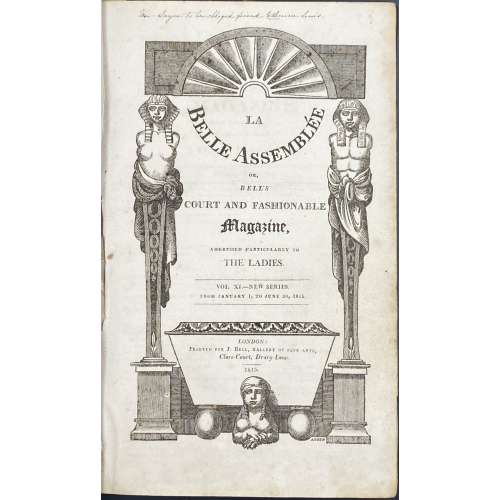 Title: LA | BELLE ASSEMBLÉE | OR, | BELL'S | COURT AND FASHIONABLE | MAGAZINE, | ADDRESSED PARTICULARLY TO | THE LADIES. | VOL. XI.—NEW SERIES. | FROM JANUARY 1, TO JUNE 30, 1815. | LONDON: | Printed for J. BELL, GALLERY OF FINE ARTS, | Clare-Court, Drury-Lane. | 1815. || Pagination: [2] – 11th volume wood-engraved pictorial title page, [1, 2] – January faux-title and table of content, [3] 4-284 [2] – index to 11th vol. Notes: February f.t. not paginated, but within the collation; the last page of the index at the very end paginated [iii]/iv, so pages i/ii missing (the gathering Nn lacking one sheet) Collation: 4to; π1 A-Mm4 Nn3, 28 plates extraneous to collation (lacking 2 plates). Binding: Half brown morocco over marbled boards, flat spine, compartments gilt-ruled with double-fillet and gilt-lettered. Contents: Jan: pp. 1-48, 5 plates. Feb: pp. 51-96, 5 plates. Mar: pp. 97-144, 5 plates. Apr: pp. 145-192, 5 plates. May: pp. 193-240, 5 plates. Jun: pp. 241-284, 3 plates (lacking 2 colour prints). Fashion plates, two per issue, are hand-coloured copperplate engravings, unsigned. Stipple engraved portraits, one per issue as frontispiece: (1) Actress Catherine Stephens, Countess of Essex (British, 1794 – 1882) by James Hopwood the Elder [James Hopwood Senior] (British, c. 1740s/50s – 1819) after Sir George Hayter (British, 1792 – 1871); (2) Madame de Talleyrand, Princesse De Bénévent (Danish-French, 1761– 1834), unsigned, but can be attributed to François Gérard (French, 1770 – 1837); (3) Actress Miss Sarah Booth (1793 – 30 December 1867), unsigned; (4) Group portrait of the French Royal family (Louis XVI, Louis XVII, Marie Antoinette, Madam Elizabeth, Louis Antoine de Bourbon, Duke d'Enghien, and Marie Thérèse Louise of Savoy, Princesse de Lamballe), unsigned, (5) Actress, Miss Sarah Blanche Matthews (b.1794) by Thomas Burke (Irish, 1749 – 1815) after George Hayter. The sixth print, in the March issue, is a lithographic portrait of Napoléon Bonaparte (French, 1769 – 1821), unsigned.
Title: LA | BELLE ASSEMBLÉE | OR, | BELL'S | COURT AND FASHIONABLE | MAGAZINE, | ADDRESSED PARTICULARLY TO | THE LADIES. | VOL. XI.—NEW SERIES. | FROM JANUARY 1, TO JUNE 30, 1815. | LONDON: | Printed for J. BELL, GALLERY OF FINE ARTS, | Clare-Court, Drury-Lane. | 1815. || Pagination: [2] – 11th volume wood-engraved pictorial title page, [1, 2] – January faux-title and table of content, [3] 4-284 [2] – index to 11th vol. Notes: February f.t. not paginated, but within the collation; the last page of the index at the very end paginated [iii]/iv, so pages i/ii missing (the gathering Nn lacking one sheet) Collation: 4to; π1 A-Mm4 Nn3, 28 plates extraneous to collation (lacking 2 plates). Binding: Half brown morocco over marbled boards, flat spine, compartments gilt-ruled with double-fillet and gilt-lettered. Contents: Jan: pp. 1-48, 5 plates. Feb: pp. 51-96, 5 plates. Mar: pp. 97-144, 5 plates. Apr: pp. 145-192, 5 plates. May: pp. 193-240, 5 plates. Jun: pp. 241-284, 3 plates (lacking 2 colour prints). Fashion plates, two per issue, are hand-coloured copperplate engravings, unsigned. Stipple engraved portraits, one per issue as frontispiece: (1) Actress Catherine Stephens, Countess of Essex (British, 1794 – 1882) by James Hopwood the Elder [James Hopwood Senior] (British, c. 1740s/50s – 1819) after Sir George Hayter (British, 1792 – 1871); (2) Madame de Talleyrand, Princesse De Bénévent (Danish-French, 1761– 1834), unsigned, but can be attributed to François Gérard (French, 1770 – 1837); (3) Actress Miss Sarah Booth (1793 – 30 December 1867), unsigned; (4) Group portrait of the French Royal family (Louis XVI, Louis XVII, Marie Antoinette, Madam Elizabeth, Louis Antoine de Bourbon, Duke d'Enghien, and Marie Thérèse Louise of Savoy, Princesse de Lamballe), unsigned, (5) Actress, Miss Sarah Blanche Matthews (b.1794) by Thomas Burke (Irish, 1749 – 1815) after George Hayter. The sixth print, in the March issue, is a lithographic portrait of Napoléon Bonaparte (French, 1769 – 1821), unsigned. -
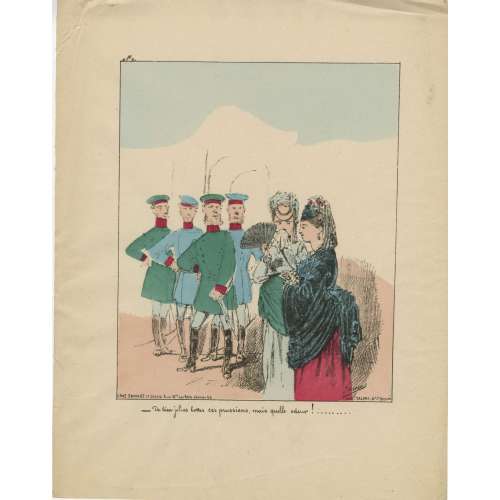 Artist: James (nothing else is known). According to Maurice Quentin-Bouchart (p. 95), this is sheet №2 of only two known caricatures by James except for Collection Wentzell (publisher) of 14 sheets. Text: De bien jolies bottes, ces Prussiens, mais quelle odeur!..... [What beautiful boots these Prussians have, but what an odour!.....] Two women from the bourgeoisie stand in front of a line of Prussian officers. One covers her nose with a handkerchief and hides what she is saying from the men with her fan.
Artist: James (nothing else is known). According to Maurice Quentin-Bouchart (p. 95), this is sheet №2 of only two known caricatures by James except for Collection Wentzell (publisher) of 14 sheets. Text: De bien jolies bottes, ces Prussiens, mais quelle odeur!..... [What beautiful boots these Prussians have, but what an odour!.....] Two women from the bourgeoisie stand in front of a line of Prussian officers. One covers her nose with a handkerchief and hides what she is saying from the men with her fan. -
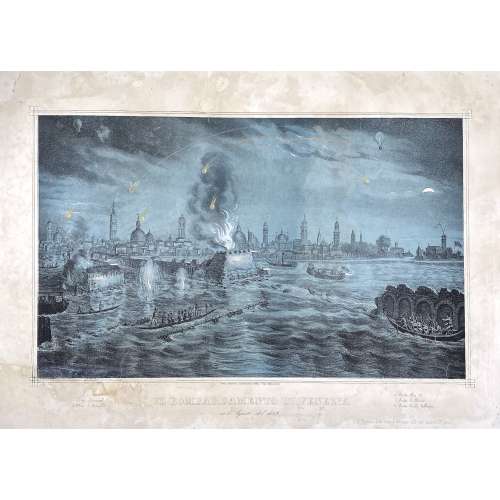 Quaritch's description: Single sheet (435 x 625 mm); coloured lithograph by Kirchmayr after a drawing by M. Fontana; hand-painted details; signed to lower left ‘M. Fon[tana]’ and to lower right ‘M. Fontana Edit. Prop. S. Giacomo dall’Orio in Isola N°.1481’; lower margin with the title ‘Il bombardamento di Venezia nell’Agosto 1849’ and key; restored tears in many places, especially along upper and lower blank margins, some affecting print; losses to lower left corner, affecting a small portion of the print, ruled border, and key, restored and re-drawn where needed; loss to the upper left corner of blank margin; two small areas of restoration to the centre of upper blank margin; the whole sheet backed; nevertheless a remarkable survival. Exceedingly rare and striking lithograph of Venice as seen from Fusina, depicting the first ever aerial bombardment in history. The bombardment took place in 1849, under the orders of Field Marshal Josef Radetzky (1766–1858), to quell the revolts that had started the previous year during the First Italian War of Independence. This curious and little-known action was the brainchild of Colonel Benno Uchatius, a brilliant young officer in the Austro-Hungarian Artillery. After long months of unsuccessful siege, Uchatius decided to deploy an unusual weapon: a hot air balloon able to bomb the city from above. Having calculated the wind speed and direction and evaluated the requisite dimensions of the hot-air balloon, Uchatius set up a workshop near Mestre, where a group of engineers and craftsmen began to manufacture a balloon equipped with a large wicker basket which could transport two crewmen and approximately one hundred kilograms of small long-fuse devices (metal spheres filled with gunpowder, pitch, oil and five hundred rifle buckshot). The initial trials, however, proved to be a disaster, because the balloon would drift off course, making it impossible to accurately deploy the bombs. Uchatius then hit upon the idea of using several smaller unmanned balloons roped together. These were to be launched over the city and, using the position of the first ‘pilot’ balloon, which was unarmed, the Austrians could calculate the correct fuse settings for the bombs. The ‘bomber’ balloons had a cloth envelope of one hundred cubic metres and a reduced load of about twenty kilograms of ordnance. According to Uchatius’ calculations, the line of balloons, launched from Mestre, would reach the lagoon city in thirty-five to forty minutes, carried by the north-west wind. In July 1849, a first launch was attempted, but when a breeze began to blow from the sea some of the balloons broke the connecting ropes and floated away, while others settled in the water in front of the northern part of the city, where a curious crowd of Venetians observed the failure of the enterprise and commented colourfully on the ‘buffoonery of Radetzky’. Uchatius’ second attempt, which is depicted in this lithograph, was also largely unsuccessful: only a few of the unmanned bomber balloons reached their target, and some even drifted back over the Austrian lines. Uchatius, having accomplished the first ever aerial bombardment, and having designed the first ever military ‘drones’, was forced to abandon the project permanently. Another fascinating aspect of this work is the vantage point used to depict the city of Venice, seen here from Fusina, a very rare viewpoint that makes this piece even more remarkable. We were unable to locate any copies in any institution or bibliography. G. Kirchmayr (fl. mid-19th century) is mentioned at British Museum database as "Lithographer active in Venice; related to Venetian painter Cherubino Kirchmayr (b. 1848)?" However, I was not able to find that name on the print. Not much is known of M. Fontana either.
Quaritch's description: Single sheet (435 x 625 mm); coloured lithograph by Kirchmayr after a drawing by M. Fontana; hand-painted details; signed to lower left ‘M. Fon[tana]’ and to lower right ‘M. Fontana Edit. Prop. S. Giacomo dall’Orio in Isola N°.1481’; lower margin with the title ‘Il bombardamento di Venezia nell’Agosto 1849’ and key; restored tears in many places, especially along upper and lower blank margins, some affecting print; losses to lower left corner, affecting a small portion of the print, ruled border, and key, restored and re-drawn where needed; loss to the upper left corner of blank margin; two small areas of restoration to the centre of upper blank margin; the whole sheet backed; nevertheless a remarkable survival. Exceedingly rare and striking lithograph of Venice as seen from Fusina, depicting the first ever aerial bombardment in history. The bombardment took place in 1849, under the orders of Field Marshal Josef Radetzky (1766–1858), to quell the revolts that had started the previous year during the First Italian War of Independence. This curious and little-known action was the brainchild of Colonel Benno Uchatius, a brilliant young officer in the Austro-Hungarian Artillery. After long months of unsuccessful siege, Uchatius decided to deploy an unusual weapon: a hot air balloon able to bomb the city from above. Having calculated the wind speed and direction and evaluated the requisite dimensions of the hot-air balloon, Uchatius set up a workshop near Mestre, where a group of engineers and craftsmen began to manufacture a balloon equipped with a large wicker basket which could transport two crewmen and approximately one hundred kilograms of small long-fuse devices (metal spheres filled with gunpowder, pitch, oil and five hundred rifle buckshot). The initial trials, however, proved to be a disaster, because the balloon would drift off course, making it impossible to accurately deploy the bombs. Uchatius then hit upon the idea of using several smaller unmanned balloons roped together. These were to be launched over the city and, using the position of the first ‘pilot’ balloon, which was unarmed, the Austrians could calculate the correct fuse settings for the bombs. The ‘bomber’ balloons had a cloth envelope of one hundred cubic metres and a reduced load of about twenty kilograms of ordnance. According to Uchatius’ calculations, the line of balloons, launched from Mestre, would reach the lagoon city in thirty-five to forty minutes, carried by the north-west wind. In July 1849, a first launch was attempted, but when a breeze began to blow from the sea some of the balloons broke the connecting ropes and floated away, while others settled in the water in front of the northern part of the city, where a curious crowd of Venetians observed the failure of the enterprise and commented colourfully on the ‘buffoonery of Radetzky’. Uchatius’ second attempt, which is depicted in this lithograph, was also largely unsuccessful: only a few of the unmanned bomber balloons reached their target, and some even drifted back over the Austrian lines. Uchatius, having accomplished the first ever aerial bombardment, and having designed the first ever military ‘drones’, was forced to abandon the project permanently. Another fascinating aspect of this work is the vantage point used to depict the city of Venice, seen here from Fusina, a very rare viewpoint that makes this piece even more remarkable. We were unable to locate any copies in any institution or bibliography. G. Kirchmayr (fl. mid-19th century) is mentioned at British Museum database as "Lithographer active in Venice; related to Venetian painter Cherubino Kirchmayr (b. 1848)?" However, I was not able to find that name on the print. Not much is known of M. Fontana either. -
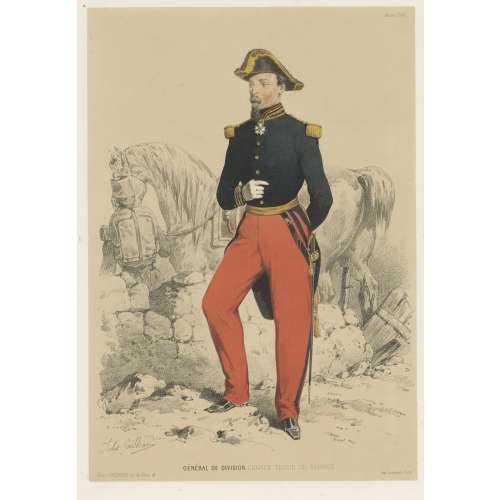 Chromolithography on thick wove paper, 473 x 315 mm sheet, 372 x 260 mm image, black ink stamp “5050” to reverse. Signed on stone "Jules Gaildrau"; below centre: "GÉNERAL DE DIVISION, GRANDE TENUE DE SERVICE"; Bottom left: "Paris, J. Gaildrau, rue de Seine, 16"; right: "Imp. Lemercier, Paris." Joseph Lemercier (French, 1803 – 1887) – printer. Jules Gaildrau (French, 1816 – 1898) – artist.
Chromolithography on thick wove paper, 473 x 315 mm sheet, 372 x 260 mm image, black ink stamp “5050” to reverse. Signed on stone "Jules Gaildrau"; below centre: "GÉNERAL DE DIVISION, GRANDE TENUE DE SERVICE"; Bottom left: "Paris, J. Gaildrau, rue de Seine, 16"; right: "Imp. Lemercier, Paris." Joseph Lemercier (French, 1803 – 1887) – printer. Jules Gaildrau (French, 1816 – 1898) – artist. -
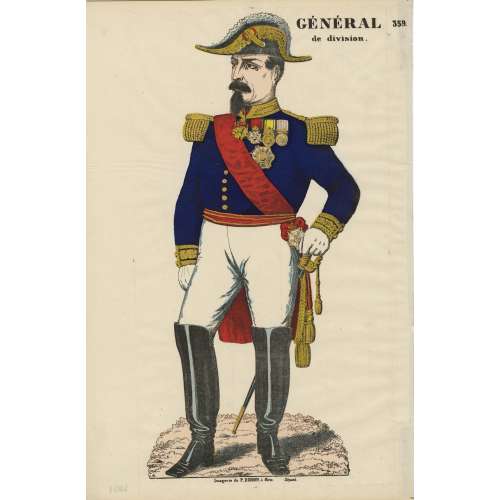 Hand-coloured woodcut on wove paper, 430 x 285 mm; black ink stamp “5051” to reverse. Top right: "GÉNÉRAL | de division." — "359." Bottom: "Imagerie de DIDION, à Metz. Déposé." Paulin Didion (French, 1831 – 1879) – publisher/printer.
Hand-coloured woodcut on wove paper, 430 x 285 mm; black ink stamp “5051” to reverse. Top right: "GÉNÉRAL | de division." — "359." Bottom: "Imagerie de DIDION, à Metz. Déposé." Paulin Didion (French, 1831 – 1879) – publisher/printer. -
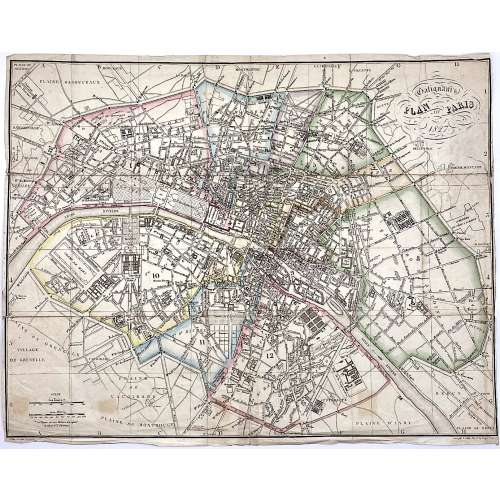 Upper right: Galignani's | PLAN OF PARIS | 1827 || in oval frame: Sauve sculpt. Bottom, under the frame: le Plan écrit par Lallemand. […] Gravé par E. Collin. Rue de la Harpe № 45. Dimensions: 36.5 x 46.5 cm. Armand Joseph Lallemand (French, c. 1810 - 1871) – cartographer. Charles-Étienne Collin (French, 1770 – 1840) – engraver. Étienne Collin II (French,1790 – 1852) – engraver. John Anthony Galignani (Italian, 1796 – 1873) – publisher. William Galignani (Italian, 1798 – 1882) – publisher.
Upper right: Galignani's | PLAN OF PARIS | 1827 || in oval frame: Sauve sculpt. Bottom, under the frame: le Plan écrit par Lallemand. […] Gravé par E. Collin. Rue de la Harpe № 45. Dimensions: 36.5 x 46.5 cm. Armand Joseph Lallemand (French, c. 1810 - 1871) – cartographer. Charles-Étienne Collin (French, 1770 – 1840) – engraver. Étienne Collin II (French,1790 – 1852) – engraver. John Anthony Galignani (Italian, 1796 – 1873) – publisher. William Galignani (Italian, 1798 – 1882) – publisher. -
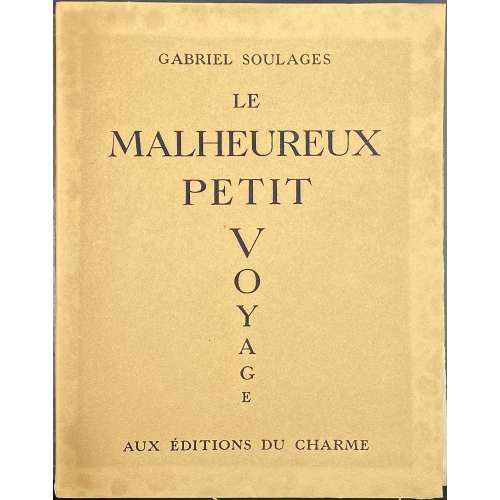 Description: Softcover 4to volume 25 x 19.7 cm in publisher’s French flapped tan wrappers, in glassine DJ, lettering to front. Printed on watermarked “Arches” laid paper, margins untrimmed, pages uncut. Illustrated with 24 in-text coloured etchings, and 59 vignettes, initials, and tailpieces engraved on wood by Gilbert Poilliot after Maurice Leroy. Front wrapper: GABRIEL SOULAGES | LE | MALHEUREUX | PETIT | VOYAGE {vertical} | AUX ÉDITIONS DU CHARME || Title-page (red and black): GABRIEL SOULAGES | LE MALHEUREUX | PETIT VOYAGE | Illustrations de MAURICE LEROY | {fleuron} | ÉDITIONS DU CHARME | PARIS – 1942 || Pagination: [1-8] (leaf in wrapper, t.p., dedication, d.t.p.) 9-187 [188] [4] (table, colophon, leaf in wrapper), total 192 pages , incl. in wrappers. Limitation: Limited to 750 copies, 25 copies (№ 1-25) on Vélin d’Arches with the original drawings and several suites of plates, 59 copies (№ 26-84) on Vélin d’Arches with the original drawings and several suites of plates, 100 copies (№ 85-184) on Vélin d’Arches with one suite of woodcuts and one of the etchings, 216 copies (№ 185-400) on Vélin d’Arches without enrichment, 350 copies (401-750) on Vélin des Papeteries Lana (Docelles); besides there are 10 copies numbered I-X for the artist and collaborators. This copy is № 266. Edition made under the direction of Sven Nielsen and Robert Meiffrédy; printed on April 29, 1942, at Dumoulin under the direction of H. Barthélemy. Etchings were printed at La Tradition under the direction of H. Durupt and the artist. Gabriel Soulages (French, 1876 – 1930?) – author. Maurice Leroy (French, 1885 – 1973) – artist. Gilbert Poilliot (French, fl. 1938 – 1952) – wood engraver. Sven Nielsen (Danish, 1901 – 1976) – publisher. Robert Meiffrédy (French, 20th century) – publisher.
Description: Softcover 4to volume 25 x 19.7 cm in publisher’s French flapped tan wrappers, in glassine DJ, lettering to front. Printed on watermarked “Arches” laid paper, margins untrimmed, pages uncut. Illustrated with 24 in-text coloured etchings, and 59 vignettes, initials, and tailpieces engraved on wood by Gilbert Poilliot after Maurice Leroy. Front wrapper: GABRIEL SOULAGES | LE | MALHEUREUX | PETIT | VOYAGE {vertical} | AUX ÉDITIONS DU CHARME || Title-page (red and black): GABRIEL SOULAGES | LE MALHEUREUX | PETIT VOYAGE | Illustrations de MAURICE LEROY | {fleuron} | ÉDITIONS DU CHARME | PARIS – 1942 || Pagination: [1-8] (leaf in wrapper, t.p., dedication, d.t.p.) 9-187 [188] [4] (table, colophon, leaf in wrapper), total 192 pages , incl. in wrappers. Limitation: Limited to 750 copies, 25 copies (№ 1-25) on Vélin d’Arches with the original drawings and several suites of plates, 59 copies (№ 26-84) on Vélin d’Arches with the original drawings and several suites of plates, 100 copies (№ 85-184) on Vélin d’Arches with one suite of woodcuts and one of the etchings, 216 copies (№ 185-400) on Vélin d’Arches without enrichment, 350 copies (401-750) on Vélin des Papeteries Lana (Docelles); besides there are 10 copies numbered I-X for the artist and collaborators. This copy is № 266. Edition made under the direction of Sven Nielsen and Robert Meiffrédy; printed on April 29, 1942, at Dumoulin under the direction of H. Barthélemy. Etchings were printed at La Tradition under the direction of H. Durupt and the artist. Gabriel Soulages (French, 1876 – 1930?) – author. Maurice Leroy (French, 1885 – 1973) – artist. Gilbert Poilliot (French, fl. 1938 – 1952) – wood engraver. Sven Nielsen (Danish, 1901 – 1976) – publisher. Robert Meiffrédy (French, 20th century) – publisher. -
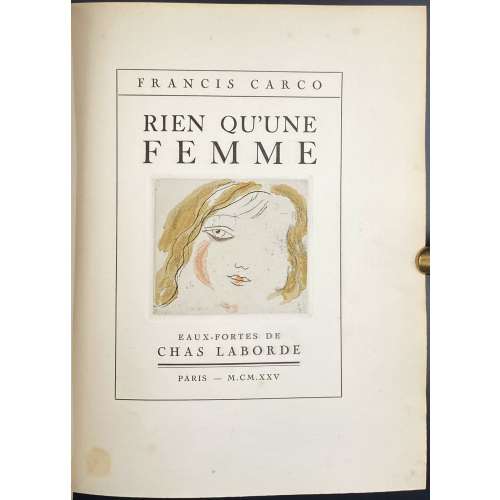 Title-page (text in frame): FRANCIS CARCO | RIEN QU'UNE | FEMME | {vignette} | EAUX-FORTES DE | CHAS LABORDE | — | PARIS — M.CM.XXV || Description: 4to, 24.5 x 20 cm, owner’s red cloth, yellow leather label with gilt lettering to spine, original wrappers bound in, woodcut bookplate “ИЗ КНИГ Ф.РОЖАНКОВСКАГО” to front pastedown; chapter titles and initials printed in pink. Collation: fep, 2 blanks before front wrapper, front wrapper with a black lettered pink label, 2 blanks, h.t., t.p., dedication, 1-204 212,2 blanks, rear wrapper, 2 blanks, rep; total 89 leaves within wrappers, plus 15 plates with tissue guards, incl. frontispiece – hand-coloured etchings by Chas [Charles] Laborde, extraneous to collation. In some copies, there are two additional plates. Pagination: [10] [1] 2-162 [2 colophon/blank] [4], total 178 pages. Limitation: Date of printing: September 15, 1925. Printer: Imprimeur Coulouma (Argenteuil) Print run: 267 copies of which 1 copy on Japon Ancien (№1), 15 on Japon Impérial (№№ 2-16), 60 on Hollande (№№ 17-76), and 200 copies on Vélin de Rives (№№ 77-276) ; this is copy № 82. Etchings printed on BFK Rives paper (embossed). Provenance: Rojankovsky, Feodor [Rojan; Рожанковский, Фёдор Степанович] (Russian-American, 1891 – 1970). Contributors: Francis Carco [François Carcopino-Tusoli] (French, 1886 – 1958) – author. Chas Laborde [Charles Laborde] (French, 1886 – 1941) – artist. Roger Lacourière (French, 1892 – 1966) – engraver.
Title-page (text in frame): FRANCIS CARCO | RIEN QU'UNE | FEMME | {vignette} | EAUX-FORTES DE | CHAS LABORDE | — | PARIS — M.CM.XXV || Description: 4to, 24.5 x 20 cm, owner’s red cloth, yellow leather label with gilt lettering to spine, original wrappers bound in, woodcut bookplate “ИЗ КНИГ Ф.РОЖАНКОВСКАГО” to front pastedown; chapter titles and initials printed in pink. Collation: fep, 2 blanks before front wrapper, front wrapper with a black lettered pink label, 2 blanks, h.t., t.p., dedication, 1-204 212,2 blanks, rear wrapper, 2 blanks, rep; total 89 leaves within wrappers, plus 15 plates with tissue guards, incl. frontispiece – hand-coloured etchings by Chas [Charles] Laborde, extraneous to collation. In some copies, there are two additional plates. Pagination: [10] [1] 2-162 [2 colophon/blank] [4], total 178 pages. Limitation: Date of printing: September 15, 1925. Printer: Imprimeur Coulouma (Argenteuil) Print run: 267 copies of which 1 copy on Japon Ancien (№1), 15 on Japon Impérial (№№ 2-16), 60 on Hollande (№№ 17-76), and 200 copies on Vélin de Rives (№№ 77-276) ; this is copy № 82. Etchings printed on BFK Rives paper (embossed). Provenance: Rojankovsky, Feodor [Rojan; Рожанковский, Фёдор Степанович] (Russian-American, 1891 – 1970). Contributors: Francis Carco [François Carcopino-Tusoli] (French, 1886 – 1958) – author. Chas Laborde [Charles Laborde] (French, 1886 – 1941) – artist. Roger Lacourière (French, 1892 – 1966) – engraver. -
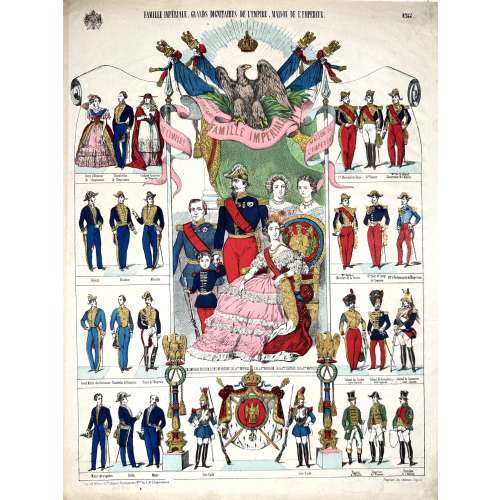 Hand-coloured woodcut on wove paper, 487 x 365 mm; black ink stamp “5056” to reverse. Top left: imperial coat of arms; centre: "FAMILLE IMPERIALE. GRANDS DIGNITAIRES DE L'EMPIRE, MAISON DE L'EMPEREUR."; right: "№144." Image of the imperial family under imperial eagle and standards; besides – four tiers of captioned cartoons. Bottom left: "Imprimerie Lith. de Pellerin, à Épinal"; right: "Propriété de l’Éditeur. — Déposé." Jean Charles Pellerin (French, 1756 – 1836) – printer/publisher.
Hand-coloured woodcut on wove paper, 487 x 365 mm; black ink stamp “5056” to reverse. Top left: imperial coat of arms; centre: "FAMILLE IMPERIALE. GRANDS DIGNITAIRES DE L'EMPIRE, MAISON DE L'EMPEREUR."; right: "№144." Image of the imperial family under imperial eagle and standards; besides – four tiers of captioned cartoons. Bottom left: "Imprimerie Lith. de Pellerin, à Épinal"; right: "Propriété de l’Éditeur. — Déposé." Jean Charles Pellerin (French, 1756 – 1836) – printer/publisher.


